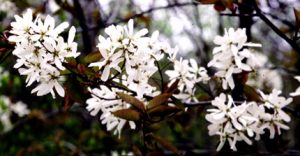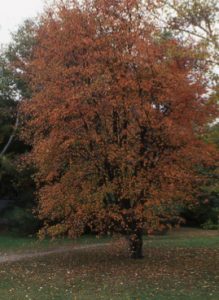Bulletin #2564, Native Trees and Shrubs for Maine Landscapes: Allegheny Serviceberry (Amelanchier laevis)
Developed by Marjorie Peronto, Associate Extension Professor, University of Maine Cooperative Extension; and Reeser C. Manley, Assistant Professor of Horticulture, University of Maine.
For information about UMaine Extension programs and resources, visit extension.umaine.edu.
Find more of our publications and books at extension.umaine.edu/publications/.
Go native!
This series of publications is the result of a five-year research project that evaluated the adaptability of a variety of native trees and shrubs to the stresses of urban and residential landscapes in Maine. Non-native invasive plants pose a serious threat to Maine’s biodiversity. Plants such as Japanese barberry, shrubby honeysuckle, and Asiatic bittersweet, originally introduced for their ornamental features, have escaped from our landscapes, colonizing natural areas and displacing native plants and animals. By landscaping with native plants, we can create vegetation corridors that link fragmented wild areas, providing food and shelter for the native wildlife that is an integral part of our ecosystem. Your landscape choices can have an impact on the environment that goes far beyond your property lines.
Description

Form: a tree with multiple upright, undulating trunks and a rounded canopy
Size: 25 to 35 feet high and from two-thirds to three-quarters as wide
Ornamental characteristics:
erect, pyramidal clusters of white flowers in mid April, before the leaves appear
mid-summer berries that change color from red to purple or black before being taken by birdsorange to red fall foliage
Landscape Use

Allegheny serviceberry is a small understory tree of cool, moist deciduous forests and upland slopes, often found growing with American hornbeam (Carpinus caroliniana) and American hophornbeam (Ostrya virginiana), as well as sugar maple (Acer saccharum), red oak (Quercus rubra), and pagoda dogwood (Cornus alternifolia). While its native habitat indicates tolerance for shade, Amelanchier laevis will also thrive in full sun if heat and drought can be avoided. Trees under severe summer drought stress often defoliate by mid August, depriving the landscape of the rich orange and red autumn leaves. In sun or shade, a moist, well-drained soil, mulching, and summer irrigation are keys to success with this species.
A. laevis can be a focal point of the spring and autumn landscape, and thus is effective as a specimen tree. Or, consider planting it as an understory tree in the woodland garden, where birds and small mammals will quickly take the ripened berries. In either case, give it the room it needs to flourish. A mature tree will grow 30 feet tall and nearly as wide. This serviceberry’s growth habit is more tree-like than its close relative, shadblow serviceberry (A. canadensis), with one to three main trunks bearing upright branches.
Culture

Hardiness: USDA zone 3a
Soil requirements: prefers moderately to well-drained soils
Light requirements: full sun
Stress tolerances:
soil compaction — intolerant
pollution — intolerant
deicing salts — intolerant
urban heat islands — intolerant
drought — intolerant
seasonal flooding — intolerant
Insect and disease problems: infrequent
Wildlife Value
Allegheny serviceberry is an early spring nectar source for bees and butterflies, and an occasional host for the larvae of viceroy, striped hairstreak, and Canadian tiger swallowtail butterflies. The berries are relished by cardinals, waxwings, hairy woodpeckers, thrushes, catbirds, orioles, and robins, as well as by squirrels and chipmunks.
Maintenance
Irrigation: During the establishment period, defined as one year after planting for each inch of trunk diameter at planting time, you should water your trees regularly during the growing season. Give the root zone of each tree 1 inch of water per week; in general, a tree’s root zone extends twice as wide as its canopy. After the establishment period, provide supplemental irrigation during periods of severe drought.
Fertilization: Landscape trees and shrubs should not be fertilized unless a soil test indicates a need. Correct soil pH, if necessary, by amending the backfill soil. No nitrogen fertilizer should be added at planting or during the first growing season.
To learn more about native woody plants
Visit the Eastern Maine Native Plant Arboretum at University of Maine Cooperative Extension’s Penobscot County office, 307 Maine Avenue in Bangor. Established in 2004, the arboretum displays 24 different native tree and shrub species that can be used in managed landscapes.
Reviewed by Cathy Neal, Extension professor, University of New Hampshire Cooperative Extension.
Photos by Reeser C. Manley.
Illustration by Margery Read, Extension Master Gardener.

This series of publications and the associated research were made possible in part by the Maine Forest Service’s Project Canopy.
Information in this publication is provided purely for educational purposes. No responsibility is assumed for any problems associated with the use of products or services mentioned. No endorsement of products or companies is intended, nor is criticism of unnamed products or companies implied.
© 2008
Call 800.287.0274 (in Maine), or 207.581.3188, for information on publications and program offerings from University of Maine Cooperative Extension, or visit extension.umaine.edu.
The University of Maine is an EEO/AA employer, and does not discriminate on the grounds of race, color, religion, sex, sexual orientation, transgender status, gender expression, national origin, citizenship status, age, disability, genetic information or veteran’s status in employment, education, and all other programs and activities. The following person has been designated to handle inquiries regarding non-discrimination policies: Sarah E. Harebo, Director of Equal Opportunity, 101 North Stevens Hall, University of Maine, Orono, ME 04469-5754, 207.581.1226, TTY 711 (Maine Relay System).

